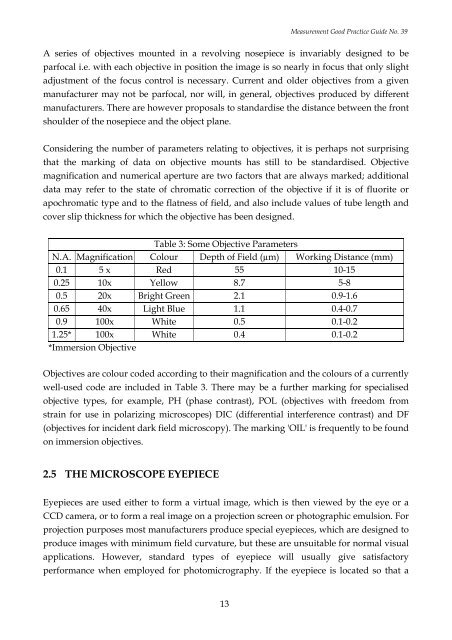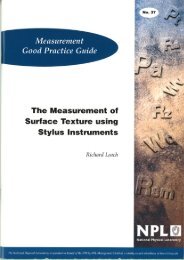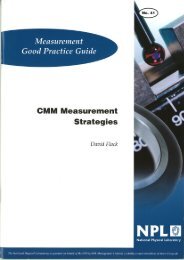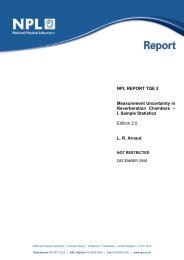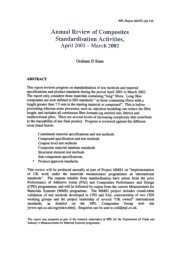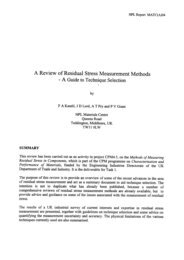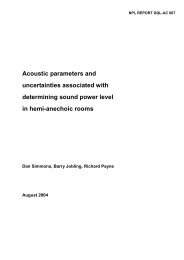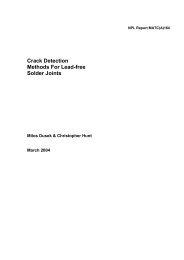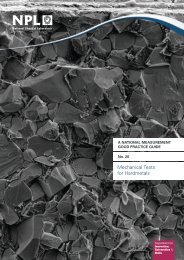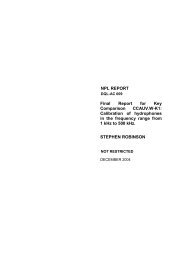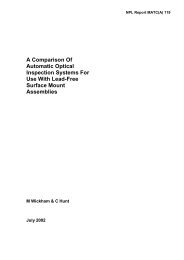Dimensional Measurement using Vision Systems - NPL Publications ...
Dimensional Measurement using Vision Systems - NPL Publications ...
Dimensional Measurement using Vision Systems - NPL Publications ...
Create successful ePaper yourself
Turn your PDF publications into a flip-book with our unique Google optimized e-Paper software.
<strong>Measurement</strong> Good Practice Guide No. 39<br />
A series of objectives mounted in a revolving nosepiece is invariably designed to be<br />
parfocal i.e. with each objective in position the image is so nearly in focus that only slight<br />
adjustment of the focus control is necessary. Current and older objectives from a given<br />
manufacturer may not be parfocal, nor will, in general, objectives produced by different<br />
manufacturers. There are however proposals to standardise the distance between the front<br />
shoulder of the nosepiece and the object plane.<br />
Considering the number of parameters relating to objectives, it is perhaps not surprising<br />
that the marking of data on objective mounts has still to be standardised. Objective<br />
magnification and numerical aperture are two factors that are always marked; additional<br />
data may refer to the state of chromatic correction of the objective if it is of fluorite or<br />
apochromatic type and to the flatness of field, and also include values of tube length and<br />
cover slip thickness for which the objective has been designed.<br />
Table 3: Some Objective Parameters<br />
N.A. Magnification Colour Depth of Field (µm) Working Distance (mm)<br />
0.1 5 x Red 55 10-15<br />
0.25 10x Yellow 8.7 5-8<br />
0.5 20x Bright Green 2.1 0.9-1.6<br />
0.65 40x Light Blue 1.1 0.4-0.7<br />
0.9 100x White 0.5 0.1-0.2<br />
1.25* 100x White 0.4 0.1-0.2<br />
*Immersion Objective<br />
Objectives are colour coded according to their magnification and the colours of a currently<br />
well-used code are included in Table 3. There may be a further marking for specialised<br />
objective types, for example, PH (phase contrast), POL (objectives with freedom from<br />
strain for use in polarizing microscopes) DIC (differential interference contrast) and DF<br />
(objectives for incident dark field microscopy). The marking 'OIL' is frequently to be found<br />
on immersion objectives.<br />
2.5 THE MICROSCOPE EYEPIECE<br />
Eyepieces are used either to form a virtual image, which is then viewed by the eye or a<br />
CCD camera, or to form a real image on a projection screen or photographic emulsion. For<br />
projection purposes most manufacturers produce special eyepieces, which are designed to<br />
produce images with minimum field curvature, but these are unsuitable for normal visual<br />
applications. However, standard types of eyepiece will usually give satisfactory<br />
performance when employed for photomicrography. If the eyepiece is located so that a<br />
13


